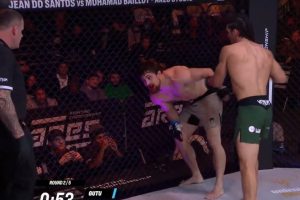Martial arts films have come a long way since the first kung fu film was made in China, which starred Beijing opera star Tan Xin-pei in Ding Jun Shan (1905). It’s been 18 years since I wrote the first Top 20 Best Martial Arts Films of All Time, and with time passages I now watch martial aspects with a different eye as I’ve learned more about fight and camera choreography, and have increased my focus on fight creativity, unique stylism and overall ingenuity. It’s why 10 of the original 20 films are no longer on the list. It’s November 2022, and here is what I consider to be The Top 10 Best Martial Arts Films of all Time.
10) The Protector (2005): Tony Jaa displays his passion for elephants in Protector by fighting like the fierce Jaturungs(guardians of the elephant’s feet that Kings rode during battle) and must rescue two elephants by defeeting animal cruelty restaurateurs in Australia. The fight that distinguishes Protector from all other films is the 4-minute oner (one continuous shot in a multi-floored restaurant), which was inspired by Bruce Lee’s Game of Death (1997) where Bruce climbs flights of stairs and fights on each floor. Each of the six floors was split into teams of stuntmen that needed to attack Jaa at the right moments. Yet in fight scenes where timing is everything, the clock didn’t always strike midnight. After eight takes, the oner that made the final cut in the film became the oner standard. Still as of this writing, none compared to Jaa’s intensely spiced and flamboyant fiery skills, thus the film’s Thai soup title, Tom Yum Goong. Yet the valiant almost 4-minute oner in Jiu Jitsu (2020), which featured Tony Jaa and Alain Moussi doing two separate oners that merge into one, is a close second.
9) Duel to Death (1983): After a trusted martial arts star/director friend told me I should watch the Rurouni Kenshin films a few months ago, I was flabbergasted as I realized how influential the father of wire-fu and director Ching Siu-tung’s Duel to Death had become. Back in 1983, it was a one-off film and I thought that was that. I was wrong and I’m sure fight choreographer and action director Kenji Tanigaki would agree. Ching’s Duel to Death is the true embodiment where the line between real and the supernatural is poetically blurred, where villains are neither human nor poltergeist. Ching proved that shooting old-fashioned sword fights at 18 frames per second didn’t make the fights look hokey but made them sing with gleeful steel slashing bewitchment. The film intelligently weaves in the traditions of the classic chivalrous and righteous lone swordsman traveling down his path of martyrdom motif with a quasi-modern, German expressionistic visual approach. Ching’s swordplay action brought decapitation to new explosive heights and human vegematics to the depths of beauteous slaughter. No one has ever done a samurai/ninja film that comes close to this one, except one film.
8) The Grandmaster (2013): While director Wong Kar-wai spent years roaming China and tracking down old kung fu masters to learn their old traditions, non-martial artist Tony Leung underwent three years of pain-ridden training and broke two bones in preparation for an unknown role. The Grandmaster focuses on Ip Man (Leung) and the martial trade secrets Wong learned from the elders. Grandmaster’s core begins when the retiring head of the kung fu world, Gong Yu-tian, tests his maybe successor Ip Man, via battles of wit, perplexing kung fu governance and subtle cryptic physical combat. It’s purposely confusing because Wong wanted to reserve the esoteric essences for insiders. Fight choreography is intelligently shaped to hide and reveal each skill as the film opens with Ip fighting 12 combatants in the evening during heavy rain, a scene shot over 30 successive nights, where Leung and stuntmen were drenched and disallowed from changing clothes for 30 days. The finale between Gong’s daughter and traitor Ma San confused Western critics; they didn’t comprehend how fa jing strikes can break one’s chi, forcing fighters to lose their abilities for life. If this confuses you, learn real kung fu.
7) The Villainess (2019): Sooh-hee (Kim Ok-bin) is a ballistic-bladed assassin coerced by an untoward agency to be a calmer, more deadly, hatchet-slashing killer. After Soohee’s opening psychotic fight on a multi-floored building full of thugs, one becomes enchanted by director Jung Byung-gil’s novel camera choreography style, what I call ping-pong camera. Imagine a ping-pong ball being a camera and instead of being struck back and forth between players with paddles it ricochets between fighters. The ball’s POV images would be tight, shaking camera angles, with rapid in and out zooms away and toward fighters creating snappy rolling pans, tilts and spins. Now have the ball hit the ground, go up in the air, through a door or out a window three-stories up while recording the actors’ reactions and the spatial displacement between them. That’s how the Villainess’ fights look. It’s ingenious and adds extra kinetic energy to the action, which if it was shot with a wide angle at 24 fps, it would look monotonous and reflect minimal training chops of the actors involved. And now you know why the Villainess used 63 days of their 70-day shooting schedule to do action.
6) John Wick: Chapter 3 – Parabellum (2019): Directed by Chad Stahelski, John Wick 3 is one of the top two best American made martial arts film where each fight features innovative fight choreography and beautifully constructed camera choreography. The fights are so gruesomely violent and ballistically brutal that they’re hilarious as hell. With a bounty on his head, the loveable John Wick’s (Keanu Reeves) survival rests upon apocalyptic action, mesmerizing mangling and grisly grappling that are akin to an exquisite ballet recital. Each fight has less editing, uses wide angles, and features long takes, often 20-25 techniques per shot. Stahelski hides nothing. Of note, at 53 and training for 6-7 months, Halle Berry learned how to fight like Keanu and do so in close proximity while shooting and kicking dozens of thugs in a desert compound. In dance, it takes two to tango, in Stahelski’s fights, it takes two to tangle.
5) Fist of Fury (1972): After the Sino-Japanese War (1894-1895), China was a fractured country and from that point on, Japan played a villainous role in Chinese history. Even after being defeated during WW II, because Japan’s post-war economy was U.S.-supported, the fear of economic backlashes against the Chinese kept Hong Kong and Taiwan (ROC) mum about Japanese atrocities committed against the Chinese during the war. Yet Bruce Lee’s Fist of Fury changed that because his character defiantly defeated Japanese martial artists in the film’s 1909 Shanghai setting, when Shanghai was under strict Japanese rule. Lee single-handedly crashed through that barrier of silence giving the Chinese a sense of identity and pride while sparking a tidal wave of nationalism amongst the world’s Chinese population. Lee also legitimized the second genre of Chinese martial arts film, the gong fu pian (kung fu films, where heroes fought with realistic skills) and brought international prominence to Hong Kong’s waning martial arts film industry. Loosely based on the death of the legendary Huo Yuin‑chia, the scene where Lee kicks eight different attackers in the Japanese dojo in one unedited, wide angle shot changed the direction of kung fu fight choreography forever then Lee introduced the world to the nunchaku.
4) Drunken Master II (1994): Although Jackie Chan’s tea house skirmish in Mr. Canton and Lady Rose (1989) features the best use of film props and set environment in a martial arts movie fight, based on fight choreography, Drunken Master 2 is Jackie Chan’s best pure kung fu film ever made. Chan reprises his legendary hero role of Huang Fei‑hung in this sequel that far surpasses its 1978 original. Huang battles traitors smuggling Chinese historical artifacts to the British. At the time of its release, Fant-Asia films were at their peak and other directors were switching to Chan’s wu da style of action. Yet Chan returned to his kung fu roots 16 years after his savvy Drunken Master (1978) to make a superior sequel. Filled with phenomenally fresh fight choreography, Chan avoided the popular bobbing style of choreography used during his first heydays as his martial skills flowed like a waterfall over smooth rocks. The final 16 minutes of the film is as mesmerizing and creative as it is relentless and exhausting to watch, and he does it without repeating the same movements. The bout with Ken Lo in the warehouse, and the spear and sword fight with the 60 year‑old Liu Chia‑liang underneath a train, once and for all shows why Chan is the best when it comes to utilizing his environment during the fight sequences.
3) Rurouni Kenshin: The Final (2021): Rurouni Kenshin’s five films feature a warped love triangle, where a supranatural swordsman is torn between two lovers, two alter egos, and two dogmas within two eras of Japanese history. Played by Takeru Satoh, on one sword, he’s Battosai, anti-Shogunate assassin who falls in love with one of his victim’s fiancé, Tomeo, her wee brother Anishi becomes his worst nightmare. On the other sword, ten years later he’s Himura, who vows not to kill and uses a reverse blade katana to protect those in need, and falls in love with Kaoru, who as Battosai, tarnished her dad’s dojo reputation. As The Final arrives, you can sense the coming madness as Shanghai mafia leader, Enishi, slithers into Tokyo with a macabre cloud of death hunters; sordid fleshy, deformed, maniacal fighters oozing psychotic creepy crawly support. Part human, part gun, part demon, they all psychotically swear to shred Battosai’s life and soul in a way he’s never seen in the Wild Wild East. Enter action director Kenji Tanigaki’s en voguevicious take, on standard samurai sword combos shot at slower frame rates. He elevates Ching Siu-tung’s frenetic paced surgical sword fights to new levels by adding far out running, sliding and jumping fight gags ala Donnie Yen’s Legend of the Fist (2010) and Legend of the Wolf (1997). As his enemies vanish like kids in Blair Witch Project (1999), Battosai’s feet dance as his body barges, evades and barrels through these horrific hoards, then when he puts his feet on the welcome mat, he says thank you very much and wipes the enemy clean during his magic carpet ride of tenacity and resolve. You blood-shot eyes will remain agog.
2) Enter the Fat Dragon (2020): This film is the result of when you mix the fight sensibilities of Bruce Lee, Jackie Chan, Jet Li, Tony Jaa, Iko Uwie, Sammo Hung and Donnie Yen wrapped into one. Enter the Fat Dragon is Yen’s Lee homage with a nod to Sammo’s Enter the Fat Dragon (1978) that combines the best martial arts fight scenes from the above filmmakers-fightmakers. It’s a kick in the groin higher note for Yen, who plays the diet challenged cop Fallon who is sent to Japan on a dregs case and ends up making minced fish out of yokel yakuzas strong arming a female sushi bar owner. The opening fatuous fight in a speeding small van, trapped between two vans, being chased by motorcycles (rings a Raid II bell) sees a skinny Fallon trying to rescue a fellow cop, as he ends up inside the van where he claustrophobically fights a bunch of bank robbers who are armed with knives and guns. The way Yen introduces a hammer and microphone into the fray is downright ingenious and funny as hell. Though using Chan environmentally influenced sets, unlike a Chan fanfare that would feature ultra-comedic sight gags, Yen features Ong Bak brutality without blood and death yet uses the rock-em sock-em robots meet rapid-fire 1980’s Hong Kong comedy gags. The finale nunchaku vs. sai fight is akin to Lee nunchaku vs. samurai sword battle from Fist of Fury, not in the comfort of a dojo but atop Tokyo Tower as an out-of-control helicopter dangerously whirls around the building, which takes the duel to new dizzying heights…it’s a real acrophobic gasser.
1) Shang-Chi and the Legend of the Ten Rings (2022): Foundation laid, pole position established, this American martial arts film is a regular riot and instant ripper that has monopolized the position of being the best martial arts film ever…for now. The fact that it’s an American made martial arts movie stuns my soul, I never imagined this happening during my lifetime since I saw Fist of Fury in 1973. The irony is that it’s the best because it’s the only film I’ve seen that beautifully incorporates the intricate fight choreography combative sensibilities of all five marital art genres in Chinese cinema history: wu xia pian; gong fu pian; quo shu pian; wu da pian; and fant-Asia films. Shang-Chi is a modern-day yarn that embraces the spirit of the Jiang Hu world (translated as the kung fu underworld in English dubbed Chinese kung fu films) to create and a new dimension in a nontraditional wuxia setting, which includes Chinese triads that transcends into beastly creatures ala Marvel Universe hysteria. Shang-Chi (Simu Liu) teams up with a hidden Jiang Hu village to fight hideous dark demons and to stop his schizoid dad from destroying Jiang Hu and the normal world. The final icing of the cake beyond the five-genre action is the fight coordinator, Andy Cheng, as he has developed his own style and flavor by adding in a secret ingredient nobody has used before…the AC Way. The next time you watch Shang-Chi, see if you can spot which fights uses which genres and where some use three genres within the same fight.
Martial arts movies, Movies, Kung fu films, Entertainment
Black Belt Magazine
Bitcoin
Ethereum
Monero

Donate Bitcoin to The Bitstream
Scan the QR code or copy the address below into your wallet to send some Bitcoin to The Bitstream

Donate Ethereum to The Bitstream
Scan the QR code or copy the address below into your wallet to send some Ethereum to The Bitstream

Donate Monero to The Bitstream
Scan the QR code or copy the address below into your wallet to send some Monero to The Bitstream
Donate Via Wallets
Select a wallet to accept donation in ETH BNB BUSD etc..












